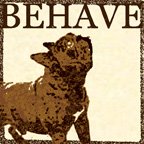Pearly Whites
"The body's natural control methods basically revolve around physical removal of plaque bacteria during eating, the antibacterial chemical and flushing actions of saliva and a cellular response involving 'neutrophil' white blood cells. When animals feed in the wild they rarely develop a serious level of periodontal disease unless they are debilitated in some other way.
If you're feeding a diet that approximates what a dog might eat in the wild things would, by the above logic, take care of themselves. But what happens when we're not. In Eti's case, although I feed him a raw diet, a fair percentage of it is premade/pre ground. Its more convenient and its safer- he's a gulper. Although he doesn't eat whole pieces all the time I do make sure he has them some of the time- things like chicken breast/backs and even larger pieces of lean meat to ensure he gets some of the physical removal of plaque as described above not to mention the psychological satisfaction of chewing and ripping through meat as he is meant to. He also gets recreational marrow bones, but this is not sufficient and if the activitiy is too vigorous can in fact wear on the tooth enamel.
If you're not feeding this way, then you have to brush your dog's teeth. The general rule is to brush every day-as long as the biofilm on the tooth is broken up once every 36 hours, plaque does not form. If it does, and it leads to tartar buildup you will need to get a professional teeth cleaning procedure done under anaesthetic. There's a recent post by Christie Keith on Pet Connection on this subject which also references Nancy Campbell's (VetTech) opinions amongst others which also, in a nutshell is- don't try to do this yourself or allow anyone other than a registered and certified veterinary technicians with special training in veterinary dentistry to do this.
Labels: Health













<< Home